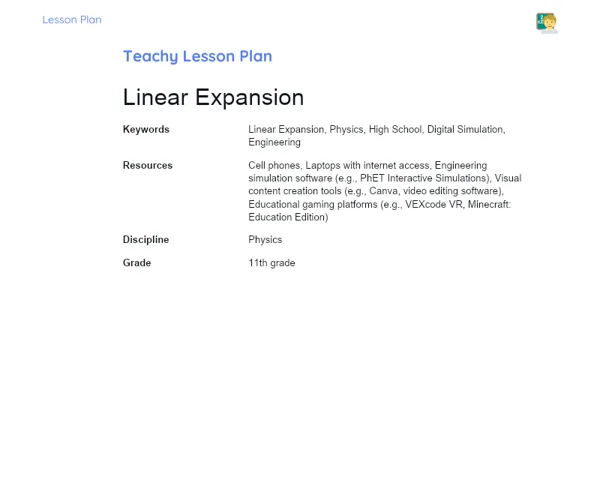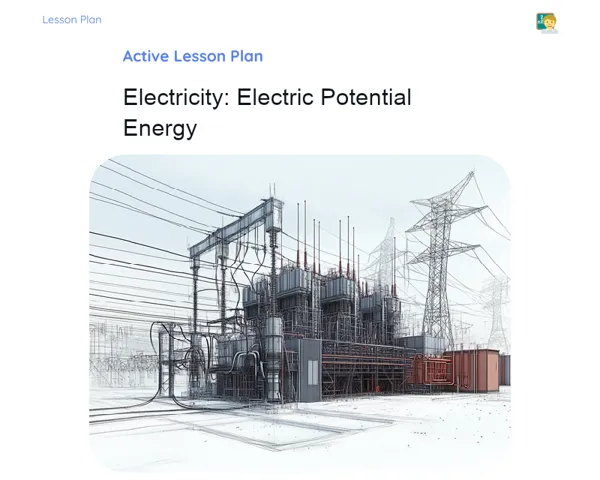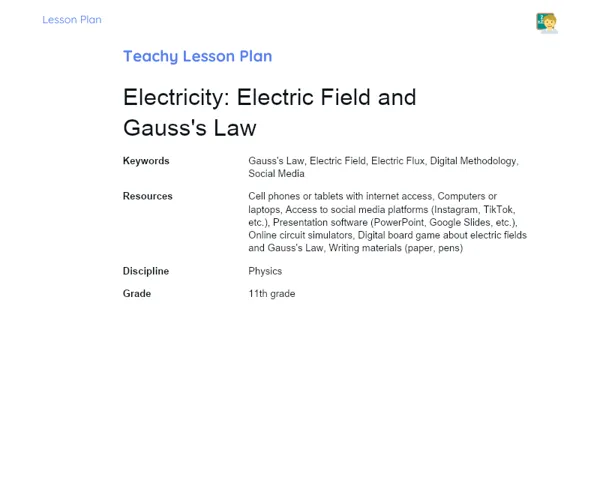Lesson Plan Teknis | Magnetism: Faraday's Law
| Palavras Chave | Faraday's Law, Electromagnetic Induction, Electromotive Force, Magnetic Flux, Electric Generator, Practical Activities, Physics Problems, Technical Skills, Job Market, Electrical Engineering |
| Materiais Necessários | Short video about electromagnetic induction, Magnets, Enameled copper wire, Small LED bulbs, Scissors, Sticky tape, AA batteries |
Objective
Duration: 10 - 15 minutes
This stage introduces the key concepts of Faraday's Law, laying the groundwork for students to engage in hands-on activities and problem-solving. By grasping the theory behind electromagnetic induction, learners will be more prepared to apply it in practical situations, cultivating valuable skills for the job market, particularly in fields like electrical engineering and new technologies.
Objective Utama:
1. Understand Faraday's Law and how it applies to electromagnetic induction.
2. Calculate the electromotive force induced in various scenarios involving changes in magnetic flux.
Objective Sampingan:
- Get acquainted with terminologies and concepts related to electromagnetism.
- Enhance critical thinking and problem-solving abilities.
Introduction
Duration: 10 - 15 minutes
Purpose: This stage introduces the essential concepts behind Faraday's Law, setting students up for practical activities and problem-solving. With a solid understanding of the theory behind electromagnetic induction, students will be better equipped to apply their knowledge in real-world contexts, honing practical skills that are increasingly important in various job markets, especially in electrical engineering and emerging tech.
Curiosities and Market Connection
Curiosities and Market Connection: Michael Faraday formulated this law in 1831, and its principles are vital for the operation of electric generators that convert mechanical energy into electricity. Moreover, it plays a significant role in the electricity supply sector, both for generation and distribution. In the job market, electrical and electronic engineers utilise these principles to innovate and enhance energy systems, including renewable sources like wind turbines and solar panels.
Contextualization
Contextualization: Faraday's Law is a cornerstone of electromagnetism, explaining how alterations in the magnetic field can generate an electric current in a circuit. This concept is fundamental to a host of modern technologies, such as electric generators, transformers, and even wireless charging for mobile devices. Understanding this law allows students to bridge theory with real-life applications and contribute to the development of new technologies.
Initial Activity
Initial Activity: Start with a short video (3-5 minutes) showcasing electromagnetic induction at work, like electricity generation in a hydroelectric plant or a basic induction experiment with a magnet and a coil. After the video, pose the thought-provoking question: 'How do you think variations in the magnetic field can be harnessed to generate electricity on a large scale?' Allow pairs to discuss their ideas briefly before opening the floor for class sharing.
Development
Duration: 45 - 50 minutes
This stage aims to solidify students' grasp of Faraday's Law and its practical implications. With hands-on tasks and problem-solving, students will develop critical and crucial technical skills, effectively linking theory to practical scenarios.
Topics
1. Faraday's Law and electromagnetic induction
2. Changes in magnetic flux
3. Induced electromotive force (EMF)
4. Real-world applications of Faraday's Law
Thoughts on the Subject
Encourage students to think about how Faraday’s Law is relevant to technologies that use electromagnetic induction, like wireless chargers, magnetic cards, and energy generators. Ask them to reflect on how these technologies affect their lives and how a solid understanding of this law could lead to technological breakthroughs.
Mini Challenge
Constructing a Basic Generator
Students will create a small electric generator using readily available materials to showcase the practical aspect of Faraday's Law.
1. Organise students into groups of 4-5.
2. Hand out the required materials: magnets, copper wire, small LED bulbs, scissors, sticky tape, and AA batteries.
3. Instruct the groups to wrap the copper wire around an AA battery to form a coil, leaving some ends loose for connection to the LED bulb.
4. Have students remove the AA battery and secure the coil with sticky tape.
5. Guide them in connecting the coil's ends to the LED bulb.
6. Show them how to swiftly move the magnet in and out of the coil to induce a current and light up the LED bulb.
7. Allow students to experiment with the speed and direction of the magnet to see variations in the brightness of the LED.
Illustrate the practical application of Faraday's Law through the creation of a basic electric generator, reinforcing their comprehension of how magnetic flux changes induce an electric current.
**Duration: 30 - 35 minutes
Evaluation Exercises
1. Calculate the induced electromotive force in a coil of 200 turns with a magnetic flux change from 0.1 Wb to 0.05 Wb in 0.02 s.
2. Discuss how Faraday's Law is applied in electric transformers.
3. Solve this problem: A circular loop with a radius of 10 cm is in a uniform magnetic field that changes over time with the function B(t) = 0.02t. Determine the induced EMF in the loop after 5 seconds.
Conclusion
Duration: 10 - 15 minutes
This conclusion segment aims to reinforce the students' learning, encouraging them to contemplate the knowledge they've gained and its practical usage. By summarising the key points and stirring discussions about their activities, students can deepen their understanding of the concepts and acknowledge the topic's significance for both the job market and daily life.
Discussion
Facilitate a wrap-up conversation with students on how Faraday's Law was evident during their practical activities. Ask them how understanding changes in magnetic flux and the induction of electromotive force can be relevant in everyday situations and the job sector. Encourage learners to share their experiences in constructing the electric generator and reflect on the challenges they faced and how they tackled them. Discuss the importance of having theoretical knowledge to address practical issues and its usefulness in careers connected to electrical engineering and other tech fields.
Summary
Provide a brief overview of what was covered in the lesson, stressing Faraday's Law and its relevance to electromagnetic induction. Recap how changes in magnetic flux can generate electromotive force, illustrated through the practical activity of building the electric generator. Highlight the significance of grasping these concepts for tackling real-world challenges and pioneering new technologies.
Closing
Wrap up by discussing how the lesson bridged theory and practice while underscoring the real-life applications of Faraday's Law. Emphasise the subject's relevance in everyday life by citing specific examples like electric generators, transformers, and wireless technology. Conclude by stressing how the insight gained can lead to innovation and open doors to opportunities in the job market, particularly in tech and engineering.



